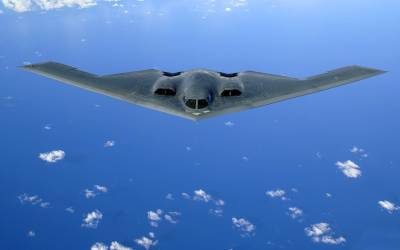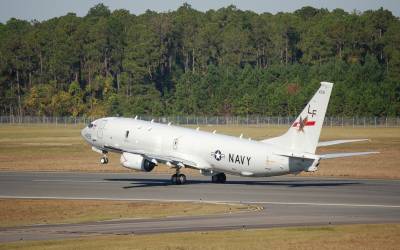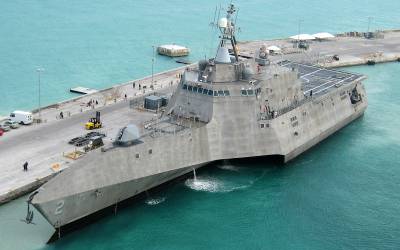April 23, 2024
USA's B-2 Bombers Leading the Way in Contracting for Availability
All together now… (click to view full) Britain’s practice of “contracting for availability” for key equipment, rather than paying for spare parts and maintenance hours, may be its most significant defense procurement reform. In a world where older air, sea, and ground vehicle fleets are growing maintenance demands beyond countries’ available budgets, it’s an approach […]
Full Article Status: free
April 19, 2024
P-8 Poseidon MMA: Long-Range Maritime Patrol, and More
P-8A Poseidon (click to view full) Maritime surveillance and patrol is becoming more and more important, but the USA’s P-3 Orion turboprop fleet is falling apart. The P-7 Long Range Air ASW (Anti-Submarine Warfare) Capable Aircraft program to create an improved P-3 began in 1988, but cost overruns, slow progress, and interest in opening the […]
Full Article Status: paid
March 29, 2024
Tomahawk's Chops: xGM-109 Block IV Cruise Missiles
Block IV Cutaway (click to view full) Block IV Tomahawk is the current generation of the Tomahawk family of cruise missiles. The BGM-109 Tomahawk family began life in the 1980s as sub-sonic, low-flying nuclear strike weapons, before being developed into long-range RGM/UGM-109 conventional attack missiles. They’re most frequently launched from submarines and surface ships, and […]
Full Article Status: free
March 4, 2024
LCS: The USA's Littoral Combat Ships
Austal Team Trimaran LCS Design (click to enlarge) Exploit simplicity, numbers, the pace of technology development in electronics and robotics, and fast reconfiguration. That was the US Navy’s idea for the low-end backbone of its future surface combatant fleet. Inspired by successful experiments like Denmark’s Standard Flex ships, the US Navy’s $35+ billion “Littoral Combat […]
Full Article Status: sample
February 27, 2024
Virginia Block III: The Revised Bow
Virginia Block I-II (click for SuperSize) “GDEB Receives $148M as Virginia Class Lead Yard” described changes to the Virginia Class submarine’s design that are expected to reach 20% of the $200 million savings goal by the time orders for the versatile sea attack/ land attack/ special forces submarines rise to 2 per year, in 2012. […]
Full Article Status: free
February 16, 2024
Tomahawk's Chops: xGM-109 Block IV Cruise Missiles
Block IV Cutaway (click to view full) Block IV Tomahawk is the current generation of the Tomahawk family of cruise missiles. The BGM-109 Tomahawk family began life in the 1980s as sub-sonic, low-flying nuclear strike weapons, before being developed into long-range RGM/UGM-109 conventional attack missiles. They’re most frequently launched from submarines and surface ships, and […]
Full Article Status: free
January 8, 2024
RIM-162 ESSM Missile: Naval Anti-Air in a Quad Pack
RIM-162: sections (click to view full) The RIM-162 Evolved Sea Sparrow Missile (ESSM) is used to protect ships from attacking missiles and aircraft, and is designed to counter supersonic maneuvering anti-ship missiles. Compared to the RIM-7 Sea Sparrow, ESSM is effectively a new missile with a larger, more powerful rocket motor for increased range, a […]
Full Article Status: paid
November 14, 2023
USAF New Bomber - B-21 - Gets a Base
B-52H, B-1B & B-2A (click to view full) The good news? 2006 saw a convergence of opinion within the USAF that a new long-range strike platform was needed. This is understandable given the B-52H Stratofortress fleet’s age (40-50 years), the B-1B Lancer’s internal power and electronics issues, both of these platforms’ low survivability against advanced […]
Full Article Status: free
November 14, 2023
P-8 Poseidon MMA: Long-Range Maritime Patrol, and More
P-8A Poseidon (click to view full) Maritime surveillance and patrol is becoming more and more important, but the USA’s P-3 Orion turboprop fleet is falling apart. The P-7 Long Range Air ASW (Anti-Submarine Warfare) Capable Aircraft program to create an improved P-3 began in 1988, but cost overruns, slow progress, and interest in opening the […]
Full Article Status: paid
November 8, 2023
Virginia Block III: The Revised Bow
Virginia Block I-II (click for SuperSize) “GDEB Receives $148M as Virginia Class Lead Yard” described changes to the Virginia Class submarine’s design that are expected to reach 20% of the $200 million savings goal by the time orders for the versatile sea attack/ land attack/ special forces submarines rise to 2 per year, in 2012. […]
Full Article Status: free
June 23, 2023
JSF's F135 Engine Meeting Milestones
Lockheed Martin and Pratt & Whitney have successfully performed the first start of an F-35 Joint Strike Fighter aircraft test engine, using an integrated power package (IPP) that the functions traditionally performed by the auxiliary power system, emergency power system, and environmental control into a single system. The system was used to start a Pratt & Whitney F135 short-takeoff/vertical-landing (STOVL) engine at the company's advanced test facility in West Palm Beach, FL. The IPP is a subsystem of the F-35 Power and Thermal Management System (PTMS)....
Full Article Status: free
June 16, 2023
Virginia Block III: The Revised Bow
Virginia Block I-II (click for SuperSize) “GDEB Receives $148M as Virginia Class Lead Yard” described changes to the Virginia Class submarine’s design that are expected to reach 20% of the $200 million savings goal by the time orders for the versatile sea attack/ land attack/ special forces submarines rise to 2 per year, in 2012. […]
Full Article Status: free
June 15, 2023
Israel's Arrow Theater Missile Defense
Arrow test concept (click to view full) In a dawning age of rogue states, ballistic missile defenses are steadily become a widely accepted necessity. Iran is widely believed to be developing nuclear capabilities, and Israeli concerns were heightened after Iranian President Mahmoud Ahmadinejad urged that Israel be “wiped off the map” (the fact that America […]
Full Article Status: free
June 1, 2023
P-8 Poseidon MMA: Long-Range Maritime Patrol, and More
P-8A Poseidon (click to view full) Maritime surveillance and patrol is becoming more and more important, but the USA’s P-3 Orion turboprop fleet is falling apart. The P-7 Long Range Air ASW (Anti-Submarine Warfare) Capable Aircraft program to create an improved P-3 began in 1988, but cost overruns, slow progress, and interest in opening the […]
Full Article Status: paid
May 26, 2023
USA's B-2 Bombers Leading the Way in Contracting for Availability
All together now… (click to view full) Britain’s practice of “contracting for availability” for key equipment, rather than paying for spare parts and maintenance hours, may be its most significant defense procurement reform. In a world where older air, sea, and ground vehicle fleets are growing maintenance demands beyond countries’ available budgets, it’s an approach […]
Full Article Status: free
May 18, 2023
LCS: The USA's Littoral Combat Ships
Austal Team Trimaran LCS Design (click to enlarge) Exploit simplicity, numbers, the pace of technology development in electronics and robotics, and fast reconfiguration. That was the US Navy’s idea for the low-end backbone of its future surface combatant fleet. Inspired by successful experiments like Denmark’s Standard Flex ships, the US Navy’s $35+ billion “Littoral Combat […]
Full Article Status: sample
April 30, 2023
Next-Stage C4ISR Bandwidth: The AEHF Satellite Program
AEHF concept (click to view full) The USA’s new Advanced Extremely High Frequency (AEHF) satellites will support twice as many tactical networks as the current Milstar II satellites, while providing 10-12 times the bandwidth capacity and 6 times the data rate transfer speed. With the cancellation of the higher-capacity TSAT program, AEHF will form the […]
Full Article Status: paid
March 17, 2023
LPD-17 San Antonio Class: The USA's New Amphibious Ships
LPD-17 cutaway (click to view full) LPD-17 San Antonio class amphibious assault support vessels are just entering service with the US Navy, and 11 ships of this class are eventually slated to replace up to 41 previous ships. Much like their smaller predecessors, their mission is to embark, transport, land, and support elements of a […]
Full Article Status: paid
March 2, 2023
Australia's Troubled E-7A "Wedgetail" AWACS Program
E-7A Wedgetail over New South Wales (click to view full) The island continent of Australia faces a number of unique security challenges that stem from its geography. The continent may be separated from its neighbors by large expanses of ocean, but it also resides within a potential arc of instability, and has a number of […]
Full Article Status: paid
December 6, 2022
USAF New Bomber - B-21 - Gets a Base
B-52H, B-1B & B-2A (click to view full) The good news? 2006 saw a convergence of opinion within the USAF that a new long-range strike platform was needed. This is understandable given the B-52H Stratofortress fleet’s age (40-50 years), the B-1B Lancer’s internal power and electronics issues, both of these platforms’ low survivability against advanced […]
Full Article Status: free









